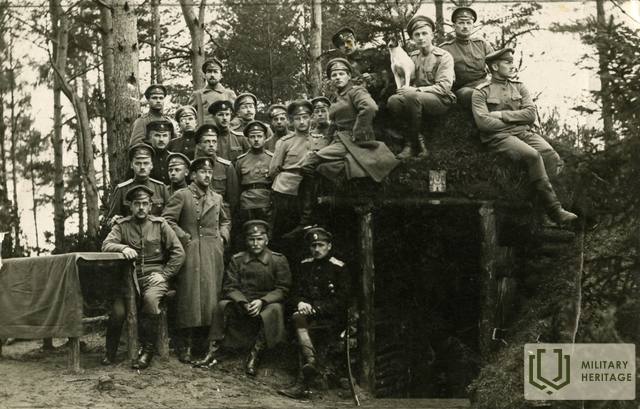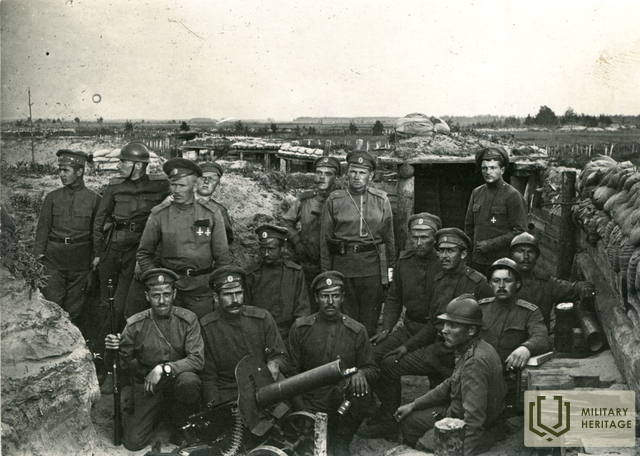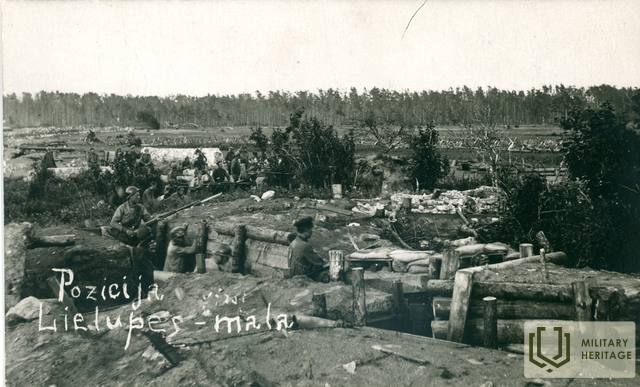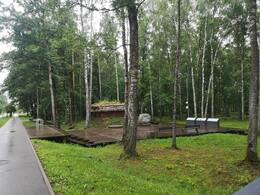Par latviešu strēlniekiem Olaines apkārtnē

Atmiņās atspoguļota latviešu strēlnieku ikdienas dzīve Olaines apkārtnē. Aprakstīti ne tikai sadzīves apstākļi, bet arī ierastais uzdevums- pretinieka pozīciju izlūkošana.
(..) Nakti pavadījām netālu no kaujas lauka artilēristu blindāžās. No rīta bija jāiet uz „Lapsām", netālu no Olaines stacijas, kur dažas dienas un naktis pavadījām zem klajas debess, mežā. Dabūdami zināt, kā vēl dažas dienas būs jāpaliek uz vietas, stāja mies enerģiski pie zemju būdu celšanas. Zemnīcām durvis, aiz dēļu trūkuma, sapinām no paegļu zariem. Eņģēm stiepules un krāsnīm ķieģeļus varēja pa pilnam dabūt nopostītajā Olaines stacijā, kur, kā mūsu kaimiņi krievi stāstīja, nevarot iet jo vācietis varot redzēt un apšaudot. Pēc apmēram kādas nedēļas atstājām „Lapsas" un devāmies uz bataljona štābu, kurš atradās pie Baložu stacijas. (..)
(..)Tiklīdz parādās vācu raķete, lai gan viņu ierakumi purva otra pusē, mēs piegulstam. Rītam austot izdalāmies retā ķēdē. Mūsu mācību komanda atrodas ķēdes labajā spārnā. Mums, iekams tiekam pie vācu ierakumiem, ilgu laiku jāiet pa sīkiem krūmiņiem, kuri piesniguši ar sniegu, pie katras pieskaršanas sniegs birst aiz apkakles, kājas stieg purvā, bet mantu maisiņš novelk plecus. Pa krūmiem ejot jāuzmanās kā viens no otra nenoklīst. Visu laiku dzirdam ķēdes kreisā spārnā, kur atradās mūsu rotas, ložmetēju šāvienus. Sāk strādāt ari mūsu artilērija. Ari mums sāk sīkt lodes pretī. Daža nosīc garām, daža izsprāgst priekšā, atsitoties pret kādu koka zariņu. Mēs nešaujam, jo ienaidnieku nevar redzēt, bet tikai ejam priekšu. Ari neviens no ienaidnieku lodēm neslēpjas. Te arī mēs varam iesākt, jo „friči" tuvu. Sākās intensīvāka apšaudīšanās. Blakus dzirdu gari stieptu vaidu, kas starp ložu sīkšanu atstāj nospiedošu iespaidu. Ir kritis viens no mūsu biedriem. Ātri viņu izģērbjam; krūtis redzams mazs caurumiņš, pa kuru aizplūst jaunā dzīvība. Krīt arī otrais. Atceros kādu Tukuma apriņķa saimnieku, Mūri jau tad ticēja Latvijai un sajuta pret vāciem vislielāko ienaidu. Viņš bija pēc kaujas nozudis. Tikai nākošā pavasari krievu kareivji bija uzgājuši viņa līķi. Neviļus rodas atziņa, kā visi tie, kuri visvairāk, latvju tautu mīlēja — visi krituši, sākot no Brieža un beidzot ar nezināmu, neievērotu strēlnieku. Ja, gaišas dvēseles viņiem bija. Pārejam kādu mežā izcirstu stigu. Nogulstam. Dažs drošsirdīgāks stāv kājās. Vācieši apklusuši. Mēs lūdzām mūsu komandieri atļaut uzbrukt vācu ierakumam, bet tā kā mūsu rotas nav varējušas iebrukt vācu ierakumos, mums tas netiek atļauts. Nav ari mums nekādu palīgspēku. Esam tikai reta ķēde. Guļam uz stigas un vērojam. Te viens no mūsu biedriem, kritis marta kaujas, drošsirdīgs kurzemnieks izšauj. Redzam, kā pāri mazajiem bērziņiem paskrien gaisā vācu kaska. Ar otru šāvienu kāds otris biedris nogalina otru vācieti. Abi vācieši nesuši patronu kasti. Te redzu krūmā pretī kaut kas kustas, saku savam biedrim blakus, kā būtu jāšauj. Šaujam abi reizē. Tūlīt pašķirās krūmi un parādās vecs vācietis ar asiņojošu roku, kurš ar savu kasku un spico bārdiņu atstāj Mefistofelim līdzīgu iespaidu. Viņš sauc, lai nešaujot, jo mājās esot pieci bērni. Saņēmām viņu gūstā, bet tam pieskarties bija organiski pretī. Viņu aizveda krievu kareivji. Ar savu salīdzinājumu, varbūt, daru viņam pārestību, varbūt, viņš bija godīgs ģimenes tēvs, atrauts no sava ikdienišķa darba, bet tanī bridi viņš atstāja sliktu iespaidu. Bija pēc tam arī gadījiens, kad ļoti biju sašutis par karu, redzot kāda grūti ievainota ienaidnieka mokas. Bet visi šādi brīži varēja atstāt tikai garāmejošu iespaidu, jo bija karš...
Laikraksts “Jēkabpils Vēstnesis”. 1925.g. janvāris.
Saistītie objekti
Pirmā pasaules kara izziņas maršruts un zemnīca Olainē
Atrodas Olainē, netālu no Olaines Vēstures un mākslas muzeja.
Vēstures izziņas maršruts izveidots 2018. gadā vietā, kur 1. pasaules kara laikā atradās Krievijas armijas nocietinājumi, kas bija daļa no apkārtnes aizsardzības sistēmas. Vācijas un Krievijas armiju cīņas Olaines apkārtnē piesaista uzmanību vairāku iemeslu dēļ. Purvainais apvidus karojošajām pusēm neļāva gūt ātrus panākumus un prasīja no karavīriem daudzveidīgas iemaņas, darbojoties nelabvēlīgos apstākļos. Precīzai apvidus analīzei, izlūkošanai un fortifikācijas jeb inženiertehniskajām būvēm bija liela nozīme karadarbībā.
Mūsdienās izziņas maršruts ir brīvi pieejams un sniedz aptuvenu priekšstatu par karavīru dzīves apstākļiem. Atjaunotās būves ir slēgtas, taču aplūkojamas, iepriekš sazinoties ar Olaines Vēstures un mākslas muzeja speciālistiem.
Olaines Vēstures un mākslas muzejs
Atrodas Olainē.
Vēstures un mākslas muzejs dibināts 1995. gadā. Muzeja ekspozīcija stāsta par Olaines un apkārtnes attīstību ietekmējošiem faktoriem un tās lomu Latvijas vēsturē. Olaine ir veidojusies, pateicoties izdevīgajai atrašanās vietai starp Jelgavu un Rīgu, kur šobrīd atrodas Jaunolaine. Tās tuvumā bija Olaines muiža. Savukārt mūsdienu Olaine būvēta Padomju okupācijas periodā, kad tur sāka attīstīt rūpniecības uzņēmumus.
1. pasaules kara laikā apkārtnē norisinājās karadarbība starp Krievijas un Vācijas armiju. Pretinieka izlūkošanā un dažādās operācijās iesaistīja latviešu strēlnieku vienības. Purvainais apvidus to padarīja par sarežģīti aizsargājamu, bet ļoti nozīmīgu cīņu vietu Latvijas vēsturē.
Mūsdienās šeit var apskatīt muzeja ekspozīcijas un 1.pasaules kara izziņas taku, kur atjaunoti nocietinājumu elementi. Jaunolainē pie pagrieziena uz Plakanciemu atrodas 1. pasaules kara dzelzsbetona nocietinājums.








